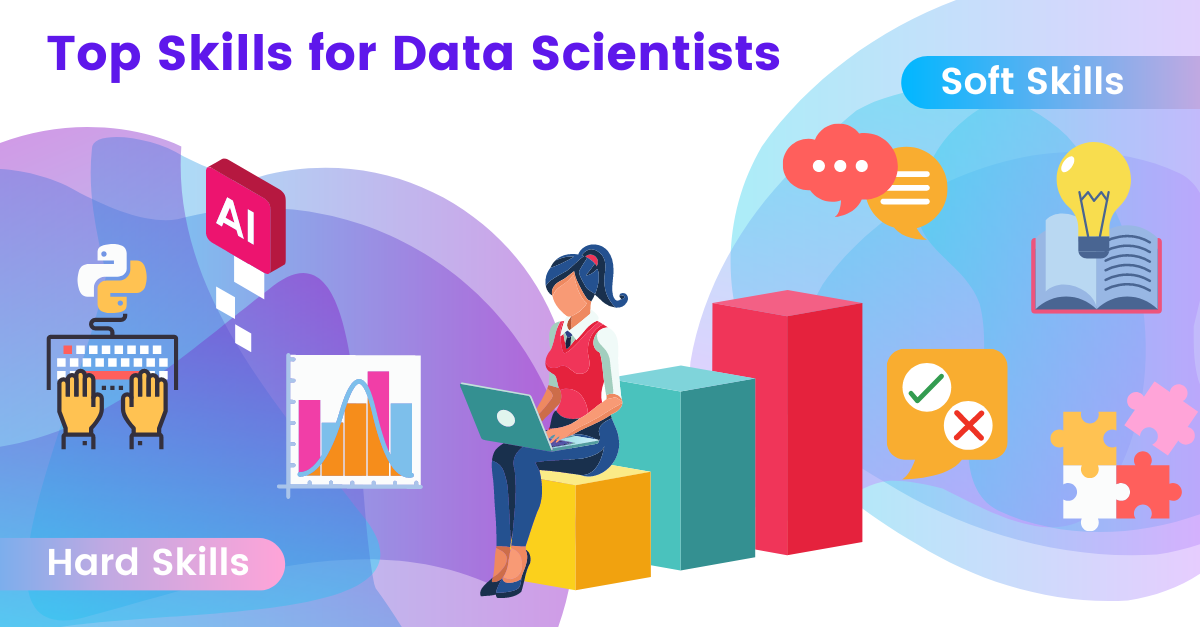The Corona pandemic continues to keep us on our toes in its second year. Most employees are still permanently in their home offices, communicating via Zoom, MS Teams or Slack and working together on projects using digital tools. For managers in particular, the changeover was initially a challenge and has since become a tour de force. This is because it took place at a speed that was born out of necessity and would otherwise have been much slower. As a result, decision-making and working from the stream feeling is becoming increasingly difficult. We will discuss below a far better alternative to gut feeling - data-driven management.
The past year has brought us a decisive point forward: The digitization of companies has been catapulted forward by involuntary, digital disruption. It is no longer a vague vision of the future, but once again determines which companies can survive in the market.

It seems that the "new twenties" are set to become a "golden age. But for whom and under what aspect? If anything determines the future and success of a company in the twenties of our current century, it is data and how it is used for decision-making.
It's not for nothing that data is said to be "the gold of the 21st century". But why is that so? When we look at tech giants like Google, Amazon or Facebook, we have to admit that the success stories of current and future companies are written from cleverly used data. However, there is a catch here: companies must also be able to use their data and make decisions based on insights from that data. The key word here is data-driven management.
All that glitters is not gold
If you look at the different companies and industries in Germany, you will see: Many companies collect data, but do not know how to use it in practice.. The immense potential of big data is wasted if the data is not analyzed. According to the "Digital Universe" study conducted by IDC International Data Corporation in 2012, just 0.5 % of all data is analyzed at all. The study also found that not all data has the potential to add value through analysis.
In 2017, the Economistthat oil would no longer be the most valuable source in the world, but from now on data would be the most sought-after raw material. From that moment on, data was compared with oil. However, a very crucial difference between the two was neglected. Unlike oil, data can be easily extracted and the supply increases exponentially. Unlike oil, data can be used multiple times and thus new insights can always be gained from it. Those who view data as the new oil may be under the misconception that collecting data alone is sufficient. Yet this is only the prerequisite for the actual benefit that data brings: Insights for fact-based, data-driven decision-making.
As a leader, data and digital transformation are everywhere, but how can you implement them internally in your company? How can an entire company be set up to be data-driven? How does everyone - from you as a leader to the team member - work and decide in a data-driven and thus evidence-based way?

* Adaptation from https://www.ibm.com/blogs/watson/wp-content/uploads/2016/07/Data-is-Transforming-Industries.png
On the road to data-driven management, it's necessary to link and coordinate a wide range of efforts - larger than most executives would like. Poor performance in any one of four interrelated areas - technology, data, process and change management - can derail an otherwise well-planned data transformation. The really important aspects, from developing and communicating a compelling vision, crafting a plan and continually tweaking it in the process, to fine-tuning the details, are ultimately all about people.
The harsh reality is that in many companies, the majority of the data available does not meet the required standards. If the transformation is to succeed, this requires:
- At least a solid data quality and analysis
- Understand new types of unstructured data (e.g., a driver-supplied image of accident damage to a car)
- Capture large amounts of data outside of your own organization
- Use and integrate proprietary data (manufacturer-specific data that can only be used in a restricted manner due to legal restrictions)
- while excluding enormous amounts of data that have never been (and will never be) used.
Data presents an interesting paradox: Most companies know that data is important, and they know that the quality of their own data is poor. Yet they squander this hugely valuable resource by failing to establish the right roles and responsibilities, and instead blame their IT departments for faltering transformation. From the Internet of Things to blockchain and data lakes to artificial intelligence, the raw potential of emerging technologies is immense. And while many of them are becoming easier to use and more widespread as a result, understanding how a particular technology will contribute to the benefits of transformation is extremely complex. What should be clear is that appropriate experts are needed to adapt a technology to the specific needs of the business and integrate it with existing systems. Complicating matters further is the fact that most companies have enormous technical debt - in the form of embedded legacy technologies that are either difficult or impossible to upgrade to new standards. These problems can only be solved with professionals who have the technical skills and are able to work hand-in-hand with the business. Ultimately, transformation will only succeed through "people skills" among employees. Because data-driven work and decision-making depends not only on technical experts, but also on the skills and the will of the managers in the companies.
Detention: Managers need to catch up in data use
Data-driven decision making has been proven to positively impact business results. By expanding your skills in data literacy, data analytics, artificial intelligence, and Big Data, you gain a tremendous opportunity to optimize your department, both internally for process optimization and for selecting the right customer segment for the next marketing campaign. However, collecting data alone is not enough for this. The skills to process it, analyze it and turn it into recommendations for action are equally needed to create real added value for the company. Professional use of data and acting on the insights generated have significant, positive effects on sales, operating costs, innovative strength, time-to-market for new products or solutions, and customer satisfaction and loyalty.
But these effects have so far fizzled out, because it's not just ordinary employees who are hesitant about using data; executives in particular often have little love for data-based decision-making. Many are faced with a flood of data and don't know which is really relevant and how it should be read in order to extract added value from it. Making decisions based on gut instinct feels easy and right. The reason is simple: almost all executives (93 percent) feel intimidated by data. That's what Oracle NetSuite's executive survey shows in its report. "Unlocking Growth.. As a result, 67 percent of respondents do not make data-driven decisions.
The right technology is not the only thing that is important for the success of digital transformation. You need the right talent and convinced data decision-makers in key positions who have a high affinity for and competence in data. At least as important is the ability to convince a large number of employees and managers to take on new roles as data customers and data creators. Specifically, this means being able to understand, think critically about, and communicate the data they need today, as well as the data they will need after transformation. It also means helping employees improve their own work processes and tasks so that they can create data correctly and use it to make decisions.
Numbers, please! Data tipping the scales
Achieving ambitious goals, continuously optimizing processes, keeping an eye on employee performance, and hiring new people at the same time. In the so-called "hypergrowth", strong growth phases, managers must be able to coordinate numerous, important leadership tasks - and preferably at triple speed. This requires clear prioritization and a reliable decision-making process.
Another barrier in this context is that executives often lack confidence in their own IT department to drive major changes independently. For holistic transformations, therefore, all departments must be involved, especially IT. Trust can and should be restored precisely for this reason by improving communication. Managers in this area must understand the strategic realignment in order to make the right, technological decisions.

In 5 steps to becoming a data-driven leader
1 - Get the executive suite on board
Transformation works best top-down. That's why the first step is to get senior management on board to successfully implement the digital transformation. It helps all employees of the company if they feel taken by the hand and supported by the management and department heads in order to carry the change as a whole. After all, the data transformation will touch every department, every employee, and will require each and every one of them to relearn. Not only employees, but also management must first want to see and implement the concrete benefits. It must be clear that strong growth does not necessarily mean increased productivity, because the transformation means upskilling and reskilling employees and a new focus in recruiting. The fact that day-to-day business will suffer temporarily should also be taken into account. For this, you need the backing of the top management. Ideally, a company-wide understanding of growth and productivity will be created. With growth and data-driven decisions, productivity and profitability will also increase in the long term.
2 - How data becomes a cash cow
The ability to make well-founded strategic decisions is the decisive prerequisite for a successful, modern company. But for that to succeed, you need reliable data that reveals potential and trends as well as clues as to where unimagined pitfalls lie dormant. Although the potential is well known, many companies still work with Excel and completely different tools depending on the department, which means they store their data in data silos instead of a unified data warehouse. This mistake creates incomplete data sets that make strategic decisions slow, error-prone, or even impossible. Data-driven organizations must perform the balancing act of keeping their tools up to date without getting lost in them. After all, it can be costly and time-consuming to keep retraining your workforce. Additionally, there is a risk that employees who don't get used to new tools will continue to use the old tools. This creates duplication and leads to overload. Streamlined processes and consistent training of the workforce are therefore important tools.
3 - Create role models and motivate
Transformations offer the risk of empty phrases in big speeches that completely miss the point of motivating. If you want to win your team over for the transformation, start where employees see actual and realistic benefits for their work. The corporate culture plays a key role in the transformation. Transparency and traceability of decisions are particularly important. This means that business decisions must be explainable on the basis of data and should be communicated internally. It is not uncommon for there to be multiple ways to address challenges. If these are made transparent, other perspectives from specialist departments and also objections can be communicated and considered. This prevents underlying assumptions that may be untrue from being used as a basis for decision-making. This is especially true for process changes where the affected employees need to be involved. In this way, you prevent processes from being adopted or even automated that do not work and must first be adapted and streamlined. Therefore, it makes sense to openly communicate the end goals right at the beginning so that employees can be involved. This makes it easier for them to understand what the purpose of an action is and to intervene if it is not fit for purpose. Break old habits of decision-making and make decisions based on factual information. Because when you make your decisions transparent, you run the risk of asking difficult and smart questions, but in doing so, you gain valuable insights and increase employees' trust in the transformation.
4 - Your own team as the gas pedal for data-driven companies
What's the first thing that comes to mind when you hear the word innovation? A new product, a machine learning algorithm, a smart new technology? Yes, all of these can be innovative, but none of them can be implemented without a team that develops and manages them. Technologies are constantly evolving and vast sums are constantly being paid into maintenance. Ironically, there is rarely any investment in developing and expanding the skills of the workforce, who are the true drivers of innovation and business value. It's not enough to hire new data experts if existing teams don't know how to incorporate the insights of a data analysis into their decisions. Invest in new technologies. Invest in capable experts. But invest equally in the skills of your employees. Only when they are prepared for the transformation will they be able to drive it forward and meet the changes with curiosity and drive. There is no need to apply a scattergun approach. Every career level and every department has its own knowledge needs and must be met exactly where they are.
5 - Become a transformation coach
Any change must start with someone who believes in it and is willing to champion it. Especially in companies that are in growth mode, many goals are being pursued simultaneously and rely on individuals to create demand and drive innovation. Innovation can start anywhere, with you, with your team and often it starts with curiosity and the desire to optimize. Everyone can become a transformation coach and create sustainable value for their team, their company, their customers and even for society, because innovation benefits everyone.
The transformation starts with you. With StackFuel, you have a strong, reliable learning partner by your side to help you along the way. We're happy to help you dive into the world of data, understand it from the ground up, and apply it to your work. No matter what department or career level you're in and where you still want to go, with us you'll learn to build your foundational data skills and get the basics for data-driven management or you can qualify for roles as a Data Analyst or Data Scientist. Our in-service online training consists of instructional videos, expert interviews, text content and interactive assignments, as well as business scenarios to apply and reinforce what you've learned. Our mentoring team will guide you throughout the training to help you reach the level of data literacy you need in a digital workplace for success today and in the future. Learn our Training offer and our Learning environment know






